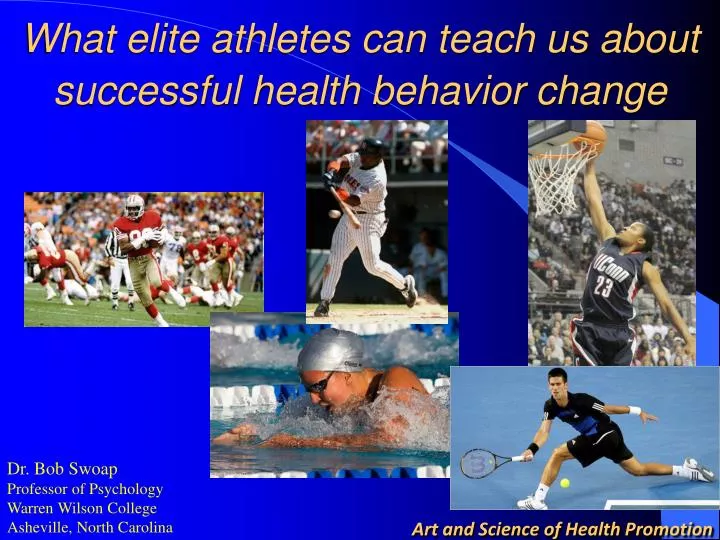
180 likes | 276 Vues
What elite athletes can teach us about successful health behavior change. Dr. Bob Swoap Professor of Psychology Warren Wilson College Asheville, North Carolina. Art and Science of Health Promotion. Dr. Seuss’ advice.

E N D
What elite athletes can teach us about successful health behavior change Dr. Bob Swoap Professor of Psychology Warren Wilson College Asheville, North Carolina Art and Science of Health Promotion
Dr. Seuss’ advice You have brains in your head. You have feet in your shoes. You can steer yourself in any direction you choose.
But HOW do I steer myself in any direction that I choose? Is it simply a matter of willpower? Is it a matter of goal-setting? Good genes?
Strategies and Skills of Elite Athletes • Vision • Habits • Teammates • Focus • Self-talk
1. Vision (& Mental Rehearsal) • Vision and goal-setting – first step • Imagining potential barriers and how one will overcome them • Ulysses contract – commitment device (Present-self is committing Future-self)
2. Establishing good habits Cue utilization
Establishing habits – keep it simple • Sean’s Rules • Rule #1 – Try For EVERY Ball. • Rule #2 – If The Ball Is Too Far Away To Reach, See Rule #1
Establishing habits – keep it simple • Reading, recognizing, and responding to cues • “Champions don’t do extraordinary things. They do ordinary things, but they do them without thinking.”
Habits (applying to behavior change) Habits are triggered spontaneously by sensory cues and preceding actions… This cueing proceeds without recourse to goal-related constructs of volition and will. Wm James 1890 When do habits persist despite conflict with motives? (Neal, Wood, et al., PSPB, 2011)
Habits (summary) (Duhigg, 2012, The Power of Habit) Provide people with concrete tools for controlling habit cueing.
3. Utilizing teammates • How many of you are on a team? • You’re on a team (whether or not you know it) • Connected – James Fowler keynote (2010) • Social network clusters for eating and smoking habits, obesity, etc. • Exercise groups (e.g., previously sedentary, post-menopausal women) • Accountability to one’s stated intentions (e.g., posting goals) • Patricia Alcivar – create a team!
5. Self-talkAnne Lundblad • How real are limits? • Surfing the urge • “I can’t do this”turns into “I am doing this.”
Putting it together Dr. Seuss says it’s easy… You have brains in your head. You have feet in your shoes. You can steer yourself in any direction you choose. Allison • Vision • Habits • Teammates • Focus • Self-talk
